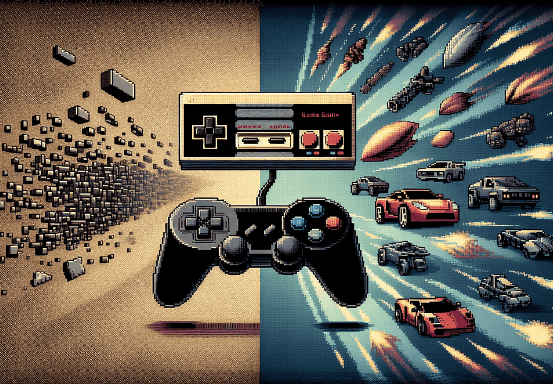The Evolution of Gaming Graphics: From Pixelated Classics to Hyperrealism

The gaming industry has evolved immensely since its inception, and one of the most striking changes has been in graphics. What began as simple pixelated characters on arcade screens has transformed into stunning, hyper-realistic graphics that blur the line between virtual and reality. The evolution of gaming graphics reflects advances in technology, growing demands from players, and the endless creativity of developers.
This journey from 8-bit graphics to hyperrealistic visuals spans decades, showing us not only how far technology has come but also where gaming might be headed next.
The Beginnings: 8-Bit and 16-Bit Graphics
The journey began with 8-bit graphics in the 1970s and early 1980s, where games like Pong and Space Invaders introduced players to the thrill of interactive visuals, albeit with extremely basic graphics. Games were composed of a limited palette and few pixels, resulting in blocky, simplistic visuals.
Iconic 8-Bit Games
One of the most iconic games of the 8-bit era is Pac-Man, with its vibrant colors and simple character designs. Donkey Kong and Super Mario Bros. also became classics with their innovative platforming mechanics and pixelated visuals. These early games may seem basic today, but at the time, they were groundbreaking.
With the rise of 16-bit consoles like the Super Nintendo Entertainment System (SNES) and Sega Genesis, game developers could create more complex and colorful graphics. This era allowed for smoother animations, richer colors, and better-defined characters, making games like Sonic the Hedgehog and The Legend of Zelda: A Link to the Past iconic for both their gameplay and visual style.
The 3D Revolution: Entering the Polygon Era
The mid-90s marked a revolutionary shift as graphics moved from 2D sprites to 3D polygons. The introduction of consoles like the Sony PlayStation and Nintendo 64 brought 3D environments, allowing players to experience immersive worlds with more depth and freedom.
Pioneering 3D Titles
Super Mario 64 and The Legend of Zelda: Ocarina of Time are often credited with setting the standard for 3D gaming. These games allowed players to explore vast landscapes and interact with objects and characters in a three-dimensional space, adding a new layer of complexity and immersion to the gaming experience.
The shift to 3D graphics also introduced players to polygonal characters, although early 3D models were still quite blocky by today’s standards. Nonetheless, the move to 3D was a major milestone that paved the way for future graphical advancements.
Enhanced Textures and Lighting: The Rise of Realism in the 2000s
As computing power grew, game developers began to incorporate advanced textures, lighting effects, and shadows to enhance the realism of graphics. The release of consoles like the PlayStation 2, Xbox, and GameCube in the early 2000s brought higher resolution textures and smoother animations, creating more lifelike characters and environments.
Iconic Games of the 2000s
Games like Grand Theft Auto III, Halo: Combat Evolved, and Final Fantasy X showcased enhanced textures and realistic environments that were far more immersive than their predecessors. Characters became more detailed, facial expressions improved, and environments looked more natural and believable.
One notable technique from this period was bump mapping, which added depth and texture to surfaces without increasing polygon count, giving the illusion of complexity and improving the visual experience without taxing the hardware too heavily.
High-Definition Graphics: The HD Era of Gaming
The arrival of the Xbox 360 and PlayStation 3 marked the start of the HD era, where games were designed for high-definition (HD) displays. With HD, developers could incorporate finer details and create even more intricate environments, enabling a leap toward realism. Graphics started to become more cinematic, with the goal of drawing players deeper into immersive story-driven games.
Major Titles in the HD Era
Games like Assassin’s Creed, The Elder Scrolls V: Skyrim, and Uncharted showcased HD graphics with remarkable realism. These games pushed the boundaries of what was possible, incorporating dynamic lighting, realistic water effects, and detailed facial animations that helped bring characters to life.
During this time, graphics engines like Unreal Engine 3 and CryEngine became popular among developers. These engines offered advanced physics, realistic lighting, and high-fidelity textures that added to the lifelike experience.
Hyperrealism and the Power of 4K: Graphics Today
With the release of consoles like the PlayStation 4, Xbox One, and the latest PlayStation 5 and Xbox Series X, as well as advancements in PC gaming technology, modern games now support 4K resolution, ray tracing, and hyper-realistic character models. Hyperrealism has become the goal for many game developers, with graphics that sometimes make it difficult to distinguish between the virtual and real world.
Key Titles in the Era of Hyperrealism
Games like Red Dead Redemption 2, Cyberpunk 2077, and The Last of Us Part II set new standards in visual fidelity. These games feature highly detailed environments, photorealistic textures, and complex animations, creating immersive experiences that were unimaginable just a decade ago.
Ray tracing technology has also revolutionized the way light and shadows are rendered, allowing for highly realistic reflections and lighting effects. This technology creates visuals that react naturally to light sources, adding depth and realism to every scene.
Virtual Reality (VR) and Augmented Reality (AR): The Next Frontier
With the rise of virtual reality (VR) and augmented reality (AR), gaming graphics are evolving yet again. VR and AR add an immersive, interactive dimension that goes beyond what traditional screens can offer. Players are no longer just observers but participants in the game world, interacting directly with the environment.
Notable VR and AR Games
Titles like Half-Life: Alyx, Beat Saber, and Pokemon Go have shown the potential of VR and AR gaming. Half-Life: Alyx uses VR technology to deliver a highly interactive environment, while Pokemon Go leverages AR to bring the game world into the real world. These technologies promise to redefine the way we perceive and interact with digital worlds.
The Role of Artificial Intelligence and Machine Learning
Another transformative technology shaping gaming graphics is artificial intelligence (AI). AI can enhance graphics by optimizing rendering processes, enabling real-time adjustments for lighting, shadows, and reflections. Machine learning algorithms can improve texture resolution, facial expressions, and even procedural generation, creating vast, lifelike worlds that respond to player actions.
The Future of Gaming Graphics: What’s Next?
The future of gaming graphics is likely to focus on greater immersion, blending realism with interactivity. Here are a few trends that might shape the next evolution in gaming graphics:
- 8K Resolution: As display technology advances, 8K resolution may become more common, offering even sharper visuals and detail.
- Advanced Ray Tracing and Global Illumination: Future games may feature even more sophisticated lighting, making environments react realistically to changes in light sources and colors.
- Photogrammetry and Scanning Technology: Photogrammetry allows developers to scan real-world objects and import them into games, creating hyper-realistic environments that mirror the real world.
- Improved VR and AR Graphics: As VR and AR technology improves, so will graphics, leading to even more immersive and lifelike experiences.
- Procedural Generation and AI-Driven Environments: AI and procedural generation will allow for endlessly evolving game worlds that feel organic and unique to each player’s experience.
Conclusion
The evolution of gaming graphics, from the simple pixels of the 8-bit era to today’s hyper-realistic visuals, is a testament to the innovation and creativity within the gaming industry. With advancements in technology, games have become more immersive, visually stunning, and realistic, offering players experiences that were once thought impossible. As we look to the future, it’s clear that gaming graphics will continue to push boundaries, taking us even closer to bridging the gap between the digital and real world.
Whether you’re a fan of retro pixel art or modern photorealism, there’s no denying that graphics have played an essential role in shaping the games we know and love today. The journey from pixelated classics to hyperrealistic visuals reflects the progress and potential of technology, and it’s exciting to think about where gaming graphics will take us next.



